Catching the magnetic wave for new devices
Natural materials interact with electromagnetic radiation because they have charges, even if they are neutral overall. However, materials also interact with electromagnetic radiation as a result of spin, a fundamental property of elementary particles. In particular, some atoms have a net spin or magnetic moment and so are called magnetic. Metamaterials are man-made materials that exhibit unique and interesting properties not seen in nature. The creation of artificial structures in magnetic materials could open the door to unforeseen properties, functionalities and applications, including magnetic field-controlled non-volatile electromagnetic devices. EU funding enabled scientists to push the frontiers of magnetism and its applications through work on the project 'Novel wave phenomena in magnetic nanostructures' (NOWAPHEN). Magnons are collective excitations of electron spin structure in a crystal lattice. Magnonic crystals, analogous to photonic crystals possessing a frequency range in which light wave propagation is forbidden (the band gap), are metamaterials that possess a periodic structure that prohibits spin wave propagation in restricted bands. NOWAPHEN scientists, through multi-lateral transfer of knowledge and expertise, conducted a plethora of innovative, proof-of-concept studies to lay the groundwork for future development of magnonic metamaterials. Their research covered fields including spintronics, magnonics, electromagnetics and microwave electronics. Numerous unprecedented results and a wealth of publications attest to the project's success. Highlights include novel characterisation methods for studying magnonic devices and magnetic properties at interfaces. Scientists discovered enhanced spin wave transmission in nanowires with a zigzag-like magnetisation state. This opens the door to utilisation of effects on propagation velocity in a velocity modulation magnonic transistor. The team also discovered a new form of magnetic anisotropy and a new class of non-reciprocal spin wave phenomena inherent to metallised magnonic crystals. Magnonics and magneto-photonics are at the forefront of a new era of discovery and magnetic devices with wave control in solids far beyond that offered by photonics and plasmonics. NOWAPHEN scientists have increased knowledge and understanding tremendously, making an important contribution to European excellence in a field that promises to be of great socioeconomic importance.







